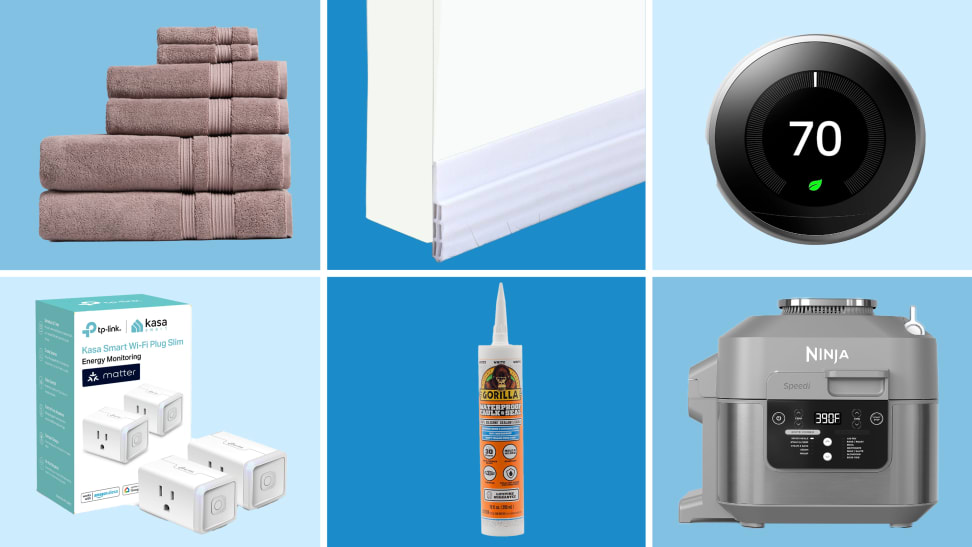You may be accidentally making your home even hotter this summer—here’s how
Ways you may be accidentally heating your home
 Credit:
Reviewed / Parachute / Save Unicorn / Google / Kasa / Gorilla / Ninja
Credit:
Reviewed / Parachute / Save Unicorn / Google / Kasa / Gorilla / Ninja
Products are chosen independently by our editors. Purchases made through our links may earn us a commission.
As summer temperatures continue to remain blisteringly high in states such as Florida, many are finding themselves returning home dripping in sweat, eager to cool off. Yet, when walking through the door, it turns out that the house that should bring relief just brings more heat. What gives? As it turns out, a lot of things from your windows, to your oven, to your doors, can actually work against you in your efforts to cool down. Today, we're going through all of the ways you may inadvertently be making your home hotter, as well as products you can use to cool your home.
Ways you’re accidentally making your home hotter
Using an oven

Thankfully, the summer season is a great time to grill outdoors and air fryers are the new kitchen staple to own.
You might want to think twice before you get to cooking. Your oven can raise the temperature of your home significantly. You won't have to order takeout to beat the heat, however. There are several ways you can enjoy a homemade meal without turning on the oven.
For one, you can use an air fryer, an absolute wonder of an appliance that can fry, bake and roast, among other functions. This allows you to make a variety of meals including the ones you'd make in an oven. The best air fryer we've tested is the Ninja Speedi Rapid Cooker & Air Fryer. The Speedi is easy to use and delivers excellent meals quickly. Most importantly, its external heat output is negligible compared to that of ovens.
You can also opt to keep the heat out of your home by cooking on a grill. There are many quality grills to choose from. If you're looking for a cooking experience similar to using an oven, we recommend going for a gas grill such as our favorite, the Weber Spirit II E-310.
Using the dishwasher’s drying option

A dish rack may take a bit longer, but it'll help bring your energy bill down.
Another kitchen appliance that may be making your house hotter, although not to the extend of your oven, is your kitchen dishwasher. If your dishwasher has a drying function, the extreme heat inside may radiate outward. We recommend interrupting the drying cycle or disabling it entirely, if possible, and making use of a drying rack instead. Our testing found Premium Racks Professional Dish Rack to be the best dish drying rack thanks to its double-decker design, two drainboards, microfiber cloth, cutlery basket and loads of other features.
Running your dryer

Although it may seem a bit dated, clotheslines are easy to use.
The third appliance that may be the culprit in your home heating woes is your dryer. While dryers are supposed to vent outside of the house, blockage or incorrect vent installation can cause the heat and steam to be trapped indoors. You'll want to troubleshoot the issue for safety issues, as well as for efficiency and reducing the heat inside. If you have the space to do so, dry your clothes outside on a clothesline instead. You might find you prefer drying outside, as it will help cut down your energy bill.
Using inefficient lightbulbs

Did you know your old lightbulbs are radiating off some major heat?
Incandescent lightbulbs can be very inefficient, expending energy as heat rather than lighting. While the heat from these bulbs that radiate into the air may be negligible, it can add up if among many appliances and it won't hurt to fix the issue. Incandescent lights are being phased out for more efficient bulbs, such as LEDs or smart bulbs, which don't grow hot when in use. If you haven't yet, you should make the switch now to keep your house cool and to save money on your energy bill.
Leaving your window shades open
Your windows may also play a part in warming up your house. If you leave the shades open, the sunlight can pass through and heat your house. Keeping the shades drawn will fix this issue. Another way your windows can heat up your house is by letting the cold air of the indoors escape or by letting hot air of the outdoors through due to poor insulation.
Inefficient doors and windows

Although your air conditioner may be running at full capacity, a combination of sunny days and gaps in your doorways may be heating up your house.
Another problem with windows is that if they aren’t secured properly, they can let in drafts from the outdoors, both cold and warm. Using window film, like this one from Lowe’s, can help to decrease the amount of sunlight radiating heat through the window and increase the window’s insulation, too.
To take it a step further, you can use caulk on your windows to close up any gaps letting air in. Gorilla’s waterproof caulk & seal has over 11,000 five-star ratings on Amazon, with reviewers loving how easy it is to spread and how quickly it dries.
Doors can lead to a sweltering house for the same reason windows can—poor insulation. If there's a gap between the door and floor or wall, even a small one, heat can radiate into your home while the cold air seeps out. A draft stop, such as this one sold on Amazon, can guard air and noise from passing from under a door. It has over 2,000 five-star reviews, with buyers loving the draft stop's simple installation and its effectiveness at keeping heat outside.
Being afraid to use your thermostat

A smart thermostat is the way to go if you want to optimize your heating and cooling thanks to built-in tech that can learn your daily patterns.
If you have a thermostat, you might be wary of cranking up the A/C to full blast because of how quickly it can add up on your energy bill. However, if you make use of a smart thermostat, you can make use of the many features that can cut down on your energy usage, such as having your air conditioning automatically shut off during times of day when no one's home. The best smart thermostat we've tested is Nest's Learning Thermostat thanks to its intuitive interface, temperature sensors and compatibility with both Amazon Alexa and Google Assistant.
Having ceiling fans spin in the wrong direction
Believe it or not, your ceiling fans may be contributing to the heat. While your fans may be giving you some relief, they can make your home feel even cooler if they spin in the correct direction. Many ceiling fans have a switch on the base that controls which way the fans spin. In the summer, your fan should be spinning counterclockwise and when standing directly below it, you should feel a column of air. When the fans are spinning in the proper direction, cool air is blown down, making the room feel cooler.
Taking a hot shower
When you get home drenched in sweat after having to brave the summer heat, it's understandable to want to clean yourself with a hot shower. That said, an overly hot shower may do you more harm than good when it comes to keeping your home cool. And cold showers can also make you hotter, as they can restrict blood from flowing close to the surface of the skin, which is one method our body uses to keep cool. For these reasons, we recommend taking a perfectly warm shower to beat the heat.
Using a hairdryer

Steam feels great while in the shower, but outside of it? Not so much.
Your hairdryer may also play a part in your home's heat. One way to solve this problem is to choose the heatless option the next time you use one. You can also forego your hairdryer entirely and opt to air dry your hair. To speed up the process is a towel, wrap your head in a towel or place it on your pillow as you sleep. The best bath towel we've tested is the Parachute Classic Bath Towel, which is highly absorbent and very comfortable.
Alternately, you don't have to dry your hair at all if you use dry shampoo instead of taking a shower. Our favorite is Dove's Volume & Fullness Dry Shampoo. It's the best dry shampoo we've tested because the spray doesn't weigh hair down or leave residue.
Leaving appliances on

Gain complete control of your energy usage with the Kasa Matter Smart Plug.
Like lightbulbs, other electrical appliances can radiate heat, something most notable in televisions. To prevent your idle devices from heating up your house, we recommend using a smart plug because you can set up timers to turn off devices at certain times. Our favorite smart plug is the one sold by Kasa Matter. We love it because it's compatible with several smart home ecosystems, it offers energy monitoring and it's compact, too.


